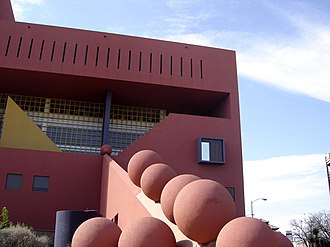Architecture of Texas







Architecture of Texas
The architecture of Texas is a reflection of the state's diverse history, culture, and geography. Texas architecture encompasses a wide range of styles and influences, from the early Spanish Colonial and Mexican periods to the modern and contemporary designs seen today.
Historical Influences[edit]
Spanish Colonial Period[edit]
The earliest architectural influences in Texas date back to the Spanish colonization in the 16th century. The Spanish missions are some of the most notable examples of this period, characterized by their use of adobe, stone, and stucco. The Alamo is one of the most famous structures from this era.
Mexican Period[edit]
Following the Mexican War of Independence, Texas became part of Mexico. During this period, Mexican architectural styles, such as the use of courtyards and flat roofs, became prevalent. The San Fernando Cathedral in San Antonio is a prime example of Mexican influence on Texas architecture.
Republic and Statehood[edit]
After gaining independence from Mexico in 1836 and becoming a state in 1845, Texas saw an influx of settlers from the United States, bringing with them various architectural styles. The Greek Revival style became popular, as seen in the Texas State Capitol building in Austin.
Modern and Contemporary Architecture[edit]
In the 20th and 21st centuries, Texas architecture has continued to evolve, incorporating modern and contemporary styles. Notable architects such as Philip Johnson, who designed the Amon Carter Museum of American Art in Fort Worth, and I.M. Pei, who designed the Dallas City Hall, have left their mark on the state's architectural landscape.
Regional Variations[edit]
Texas is a large state with diverse geographical regions, each influencing local architectural styles. In East Texas, the architecture often reflects the Southern influence, with antebellum homes and plantation-style buildings. In contrast, West Texas architecture is influenced by the desert environment, with adobe and stucco structures being common.
Notable Buildings and Structures[edit]
- The Alamo
- Texas State Capitol
- San Fernando Cathedral
- Amon Carter Museum of American Art
- Dallas City Hall
- Johnson Space Center
Related Pages[edit]
- Spanish missions in Texas
- Texas State Capitol
- San Fernando Cathedral
- Amon Carter Museum of American Art
- Dallas City Hall
- Johnson Space Center
- Greek Revival architecture
- Philip Johnson
- I.M. Pei

This article is a architecture-related stub. You can help WikiMD by expanding it!
Ad. Transform your life with W8MD's Budget GLP-1 injections from $75


W8MD offers a medical weight loss program to lose weight in Philadelphia. Our physician-supervised medical weight loss provides:
- Weight loss injections in NYC (generic and brand names):
- Zepbound / Mounjaro, Wegovy / Ozempic, Saxenda
- Most insurances accepted or discounted self-pay rates. We will obtain insurance prior authorizations if needed.
- Generic GLP1 weight loss injections from $75 for the starting dose.
- Also offer prescription weight loss medications including Phentermine, Qsymia, Diethylpropion, Contrave etc.
NYC weight loss doctor appointmentsNYC weight loss doctor appointments
Start your NYC weight loss journey today at our NYC medical weight loss and Philadelphia medical weight loss clinics.
- Call 718-946-5500 to lose weight in NYC or for medical weight loss in Philadelphia 215-676-2334.
- Tags:NYC medical weight loss, Philadelphia lose weight Zepbound NYC, Budget GLP1 weight loss injections, Wegovy Philadelphia, Wegovy NYC, Philadelphia medical weight loss, Brookly weight loss and Wegovy NYC
|
WikiMD's Wellness Encyclopedia |
| Let Food Be Thy Medicine Medicine Thy Food - Hippocrates |
Medical Disclaimer: WikiMD is not a substitute for professional medical advice. The information on WikiMD is provided as an information resource only, may be incorrect, outdated or misleading, and is not to be used or relied on for any diagnostic or treatment purposes. Please consult your health care provider before making any healthcare decisions or for guidance about a specific medical condition. WikiMD expressly disclaims responsibility, and shall have no liability, for any damages, loss, injury, or liability whatsoever suffered as a result of your reliance on the information contained in this site. By visiting this site you agree to the foregoing terms and conditions, which may from time to time be changed or supplemented by WikiMD. If you do not agree to the foregoing terms and conditions, you should not enter or use this site. See full disclaimer.
Credits:Most images are courtesy of Wikimedia commons, and templates, categories Wikipedia, licensed under CC BY SA or similar.
Translate this page: - East Asian
中文,
日本,
한국어,
South Asian
हिन्दी,
தமிழ்,
తెలుగు,
Urdu,
ಕನ್ನಡ,
Southeast Asian
Indonesian,
Vietnamese,
Thai,
မြန်မာဘာသာ,
বাংলা
European
español,
Deutsch,
français,
Greek,
português do Brasil,
polski,
română,
русский,
Nederlands,
norsk,
svenska,
suomi,
Italian
Middle Eastern & African
عربى,
Turkish,
Persian,
Hebrew,
Afrikaans,
isiZulu,
Kiswahili,
Other
Bulgarian,
Hungarian,
Czech,
Swedish,
മലയാളം,
मराठी,
ਪੰਜਾਬੀ,
ગુજરાતી,
Portuguese,
Ukrainian